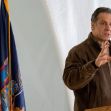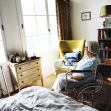Many Americans first learned about COVID-19’s lethal threats by watching news reports about rampant deaths in New York, especially in nursing homes. The tragedy foreshadowed the horror that would soon spread throughout the nation until one-third of all the 536,000 U.S. coronavirus deaths took place in elder care facilities. Now, New York, faced with 13,586 nursing home deaths of its own, is working on a broad package of new laws designed to make nursing homes safer and more accountable and to prevent similar fatal tragedies from ever happening again.
Amid this legislative frenzy, Governor Mario Cuomo, once the face of competence in the early days of COVID-19 updates, has been disgraced by many shameful acts, including vastly undercounting the coronavirus deaths in his own state’s elder care facilities. A New York Times investigation in early March shows that Cuomo deliberately obscured the actual number of nursing home fatalities in his state. While investigations into this new undercounting scandal continue, the discredited governor introduced a package of nursing home reforms on February 19, and the New York state legislature followed with its own reform proposals three days later.
According to his office, the governor’s “sweeping nursing home legislation will increase transparency, hold nursing home operators accountable for misconduct and help ensure facilities are prioritizing patient care over profits.” His announcement also pointed out the discrepancies between treatment for older adults in minority communities, although his reform package did not make specific suggestions for alleviating them.
While introducing his bill, Cuomo said, "Every day, families across the state entrust the safety and health of their loved ones to nursing homes and as this unprecedented public health crisis has shown, some performed admirably, but some did not. Facilities have put profits over care for far too long and as we look forward, we must learn from the past and prepare for the future. These facilities must be transparent and we have to have the tools necessary for holding bad actors accountable - that is the only way families will have peace of mind and I won't sign a budget that doesn't include these common-sense reforms."
Specifically, critical requirements to increase transparency will require nursing homes to post their rates on a public website along with the names of their owners. They must also post copies of all agreements with vendors that are paid for by Medicare or Medicaid, and they have to provide information about staff if they wish to open a new nursing home.
The section that hopes to hold owners accountable for misconduct vastly limits immunity. It will impose civil penalties of up to $25,000 for violations of public health laws while removing a 30-day requirement to rectify violations. It also requires any nursing home with a repeat “Infection Control Deficiency” to work with a state-designated “quality control monitor” to resolve problems. And, it streamlines the process to appoint a patient health and safety receiver.
One of the key problems with nursing home reforms, as Cuomo’s proposal suggests, comes from their extensive legal immunity from any lawsuits. This immunity has an interesting history, tied to COVID-19 relief. While an executive order providing legal immunity to these facilities expired last May, a state budget bill, signed April 3, 2020, contained provisions that not only extended immunity but expanded it to the corporate executives who run and often own the facilities as well.
The Emergency or Disaster Treatment Protection Act was created to “promote the public health, safety and welfare of all citizens by broadly protecting the health care facilities and health care professionals in this state from liability that may result from treatment of individuals with COVID-19 under conditions resulting from circumstances associated with the public health emergency.” To do this, “immunity from liability, civil or criminal” is given to health care facilities and professionals for “any harm or damages alleged to have been sustained as a result of an act or omission in the course of providing health care services” … given in good faith and according to applicable law.
A bill to strip this immunity from COVID-19 related lawsuits passed the New York State Assembly on March 4. It still needs to pass the Senate and obtain the governor’s signature.
In addition to transparency and accountability, the governor’s proposed reforms include a provision that aims to “ensure nursing home facilities are prioritizing patient care over profits.” Nursing homes will be required to spend 70% of revenues on direct patient care and 40% of revenues on staffing (sic - that’s more than 100%). It will also create a profit cap that limits “certain unscrupulous transactions” and compensation for employees who do not actively provide services.
Three days after the governor’s proposed reforms were announced, the Senate Democratic majority proposed its own legislative reforms, comprised of 19 different bills. Most agree with Cuomo’s proposals but contain a few new ones. Senator Rachel May suggests the creation of a task force to study current long-term care facilities and propose models for improvement. She also wants to expand patient-friendly ombudsman services and create a program to help visitors engage in compassionate patient care.
Bills by Senator James Skoufis would establish an audit for infection control and create quality assurance committees in all adult care facilities. He also wants every nursing home to list all health and safety violations on its website. Senator Gustavo Rivera would establish requirements for the transfer and discharge of nursing home residents. He would also require the Department of Health to record COVID-19 deaths and share data.
Many of these provisions, especially those about transfers and accurate reporting and recording of deaths, stem from misbehaviors during the COVID-19 crisis. At the start of the pandemic in March 2020, the New York State Department of Heath directed all nursing homes to accept coronavirus-positive patients because hospitals were inundated. When nursing homes requested transfers for these patients to the COVID-19-created health care sites like the Javits Center, requests were denied. As fatalities mounted, Cuomo stuck by his state directive that nursing homes had to admit patients who tested positive for COVID-19, as long as “necessary precautions” are taken.
In April, the state released its first data on nursing home deaths by facility. Press reports soon uncovered staff working while they had COVID-19. Then in May, Cuomo rescinded his controversial must-admit COVID-19 patients directive and issued a new one that required residents to have a negative COVID-19 test before admission.
In mid-May, the federal government began asking for nursing home data about deaths and including information about the number of patients who died as a result of Cuomo’s directive to patients who were transferred to nursing homes from hospitals. Cuomo claimed his report followed federal guidelines while boasting of his state’s low number of deaths.
In August, the Associated Press reported that the actual number of deaths was around 11,000, far higher than the 6,600 the state was reporting. Several investigations followed, including one by New York Attorney General Letitia James that estimated the state was “undercounting COVID-19 deaths in nursing homes and long-term care facilities by as much as 50%.” Cuomo also failed to comply with Freedom of Information Law requests from the Empire Center, which describes itself as “an independent, non-partisan, non-profit think tank in Albany.” Many meetings and a censure resolution from the legislature followed.
Then in early March, bombshells exploded. The New York Times, Wall Street Journal and New York Post reported that Cuomo’s aides had “edited” previous reports to remove higher death tolls that appeared in earlier drafts. Health officials said, “administration members made changes to downplay the impact of the directive on nursing home deaths.” One of Cuomo’s chief aides, Melissa DeRosa admitted that officials withheld accurate death data due to fears of retaliation from then-President Trump.
As scandal after scandal confronts New York’s embattled governor, and families of elderly residents who lost their lives in substandard nursing homes continue to mourn, legislation to fix a broken system is necessary and welcome.






